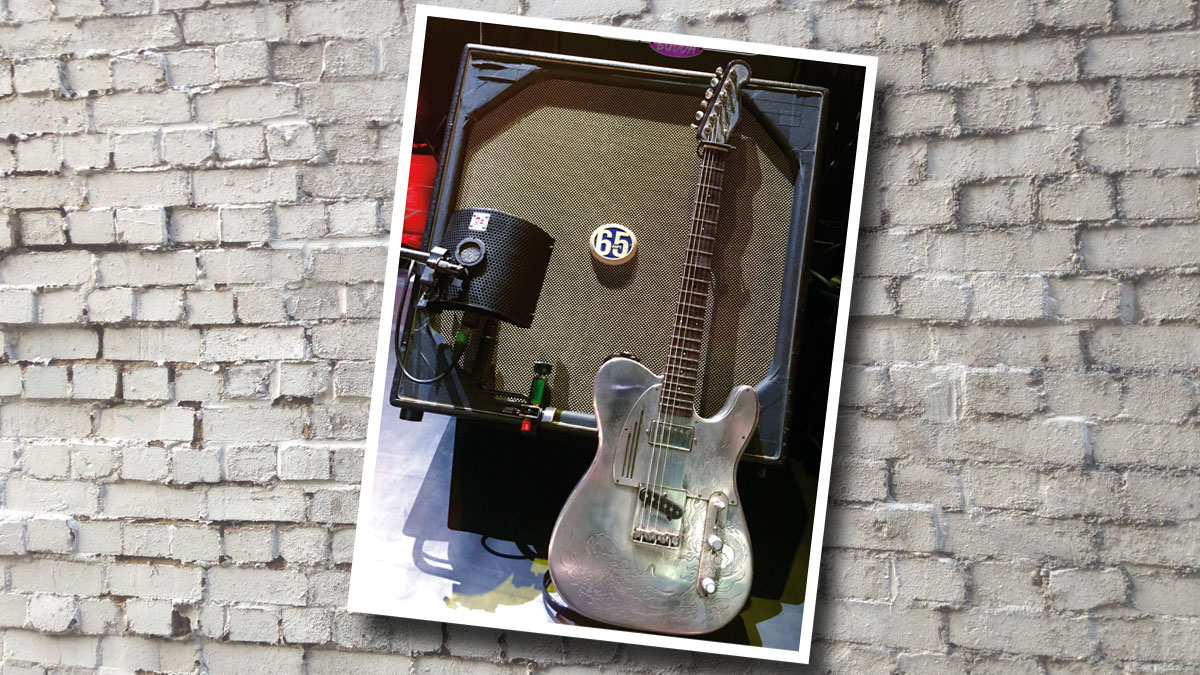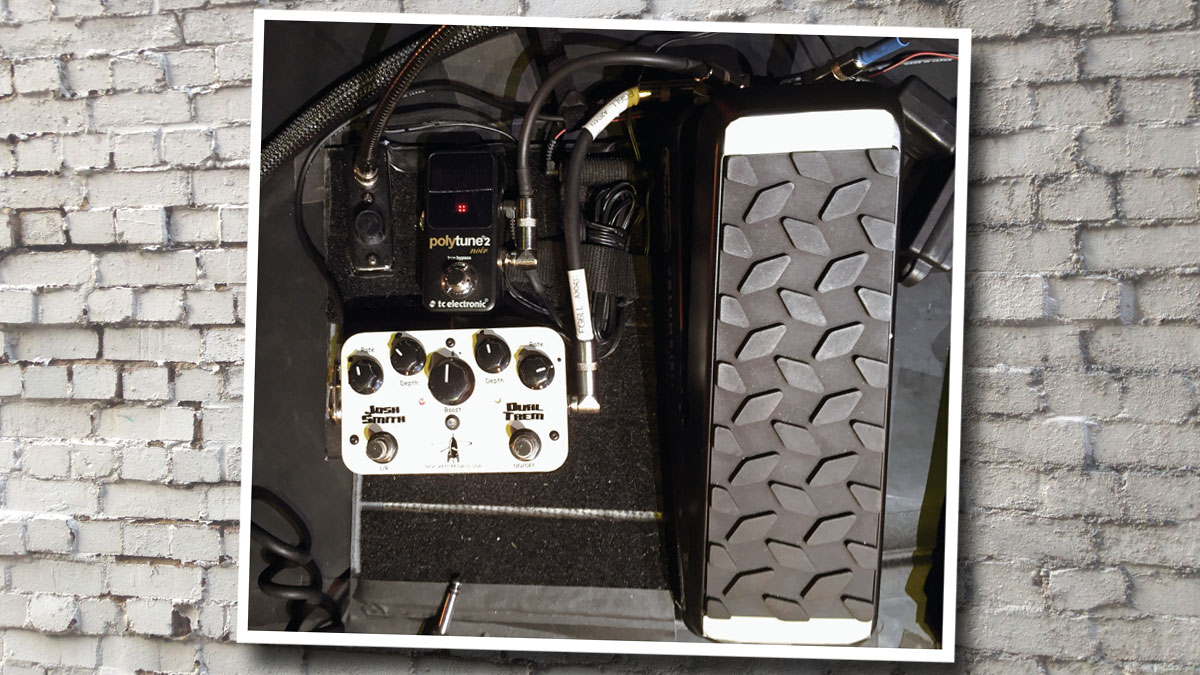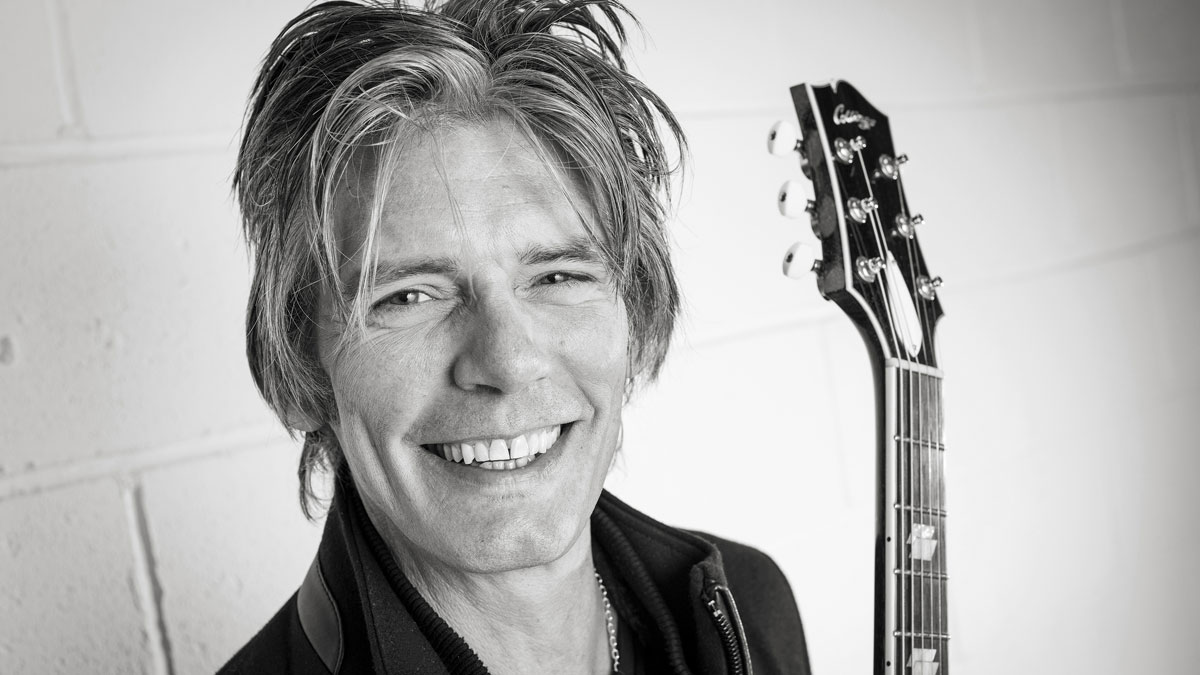Charlie Sexton talks life, tone and being on the road with Bob Dylan
The multi-talented Austin guitar-slinger talks - with full rig tour

Introduction
Solo artist, session player, producer and sideman - we catch up with Bob Dylan's go-to six-stringer, Charlie Sexton...
An everyday Cardiff cab pulls up at the city’s Musicbox Studios on an overcast October morning. Shades on, coat collar upturned, its lone passenger emerges with a gigbag and smile, proffering a handshake and cigarette as we say our hellos.
Charlie Sexton is on tour with Bob Dylan, the latest of stints in the music legend’s evolving band
“We got here around 4am, I think,” blinks the guitarist as he recounts the tour bus journey from Manchester just a few hours previously. “The gigs were great, though,” he smiles. “And The Albert Hall, too, just great.”
Charlie Sexton is on tour with Bob Dylan, the latest of stints in the music legend’s evolving band. It’s a gig that requires the right mix of ability and attitude, not to mention the kind of demeanour that’s both confident and cool around rock’s cognoscenti. Charlie Sexton, as it turns out, has plenty of form in all of the above.

Tools for touring
As we prepare to chat, Sexton pulls a well-worn Collings SoCo from the gigbag, with ‘Doghair’ back and neck finish and solid black-finished spruce top. It’s as good a place to start as any: presumably that’s among the tour instruments?
“Oh yeah, for over 50 per cent of the show. It’s a real tank,” he says, offering it for closer inspection. “More and more, this guitar is becoming Old Faithful because of the material we’re doing; the chord count is pretty big.”
If something sounds unique - it sounds like ‘a thing’ - that’s what really draws me to it
The chord count to which he’s referring is courtesy of Bob Dylan’s 2015 Sinatra/Nelson Riddle-inspired Shadows In The Night release.
“Yeah, on the recording of that material with Bob, about halfway through it I was having problems with tuning on this old Les Paul I was using. So I said, ‘Give me the Collings!’ It’s just totally reliable. I never touch this guitar, tuning-wise, the whole show, and it plays great up and down the neck.”
And the others, what else is out on tour? “There’s this early Burst Brothers ’58/’59 [Gibson Les Paul] reissue,” he continues.
“We went through about eight and this one was really like, ‘Whoa’. So that’s in the mix, and there’s also a ’54, Alnico, black [Les Paul] Custom. And that does a thing; that got used on records before the Collings was around. I mean, a ’54 Les Paul with an Alnico pickup - yep!
“There’s also a Strat with old Chandler lipstick pickups, which is the twin of the guitar I used in the Arc Angels [Sexton’s band with former Double Trouble rhythm section Tommy Shannon and Chris Layton, and also guitarist and vocalist Doyle Bramhall II].
“Part of the deal with me is that if something sounds unique - it sounds like ‘a thing’ - that’s what really draws me to it,” he expands. “A Strat, a Tele and all those bits, you know what that is, right? I also play [James] Trussart’s guitars. Largely based on the Tele mostly, but it doesn’t sound like it looks - it’s metal, so you think it’s going to be all tinny, but it’s actually super fat. The point being, everything has its purpose.”

The nod from Bob
We’re dying to ask: does Mr Dylan give the nod about which guitars are cool or not cool to use?
“Sometimes he’ll… Well, I identify with requests made by Bob,” begins Sexton, clearly being careful not to mis-represent his boss.
“I would never say I have the same aesthetic or thought process as him, but certain sounds and certain aesthetics, they achieve instantly what you want, whether that’s some nasty Sun Sessions Tele thing, or a Scotty Moore-type thing. Or a more warm, jazzy tone… Y’know, things make sense in the context of the song.”
When I began with Bob Dylan in 1999, there was a list of songs in rotation that needed to be ready to be played - around 120 or 130 songs
And how does the live show work - with Dylan’s massive repertoire, presumably there’s a great deal to learn?
“When I began with him in 1999, there was a list of songs in rotation that needed to be ready to be played, around 120 or 130 songs,” explains Sexton.
“By the time I left the first time in ’03, roughly, that book I had going of all the songs was up to around 225, maybe 240 that had either been rehearsed, played or might get played. That number just kept going up and up with new records or outside material that he wanted to play.
“There’s always been some form of list,” he expands, preempting our next question, “and recently, he’s been really methodical about how he puts the show together and we’ve been doing one kind of show with a few little things getting switched out here and there.”

Back To Austin
Sexton’s journey to Dylan’s band has been as varied as it’s been unlikely. From the bright lights of the modern tour stage, we ask him to look back to his formative years as a musician.
Having moved with his mother to Austin, Texas, he was transplanted into the heart of a musical hotbed as he grew up. What does he remember about the 80s, for example? Legend has it that Austin was alight with music, so was that all just normal to him?
“Well, nothing was normal!” he laughs. “I moved to Austin in ’72. I was four years old and immediately started going to gigs. My mom was a single mom and we never had babysitters. Except for Stevie Vaughan - he was our babysitter one day!”
I moved to Austin in ’72. I was four years old and immediately started going to gigs
Really? “Hilarious, huh,” he continues with the kind of smile that says it must be true. “Yeah, we went to his little house and he just played us Hendrix bootleg records the whole time. We lived on the outside of town and he would play this little town, San Marcos, near where we lived. There was never anybody there, just three or four people. But me and my brother would go and we’d play with him every week.
“I would walk in, and I was maybe 12 years old, in a club in Austin. It’d be the end of the night, 1:15, and I’d go there to see Stevie and he’d see me and say, ‘Hey, come here…’ So I’d go up to the stage, he’d give me his guitar and he’d go to the bar.
“That’s how I met Tommy Shannon [friend and Double Trouble bassist with whom Sexton later collaborated widely]. He was on stage and wondering why Stevie was giving his guitar to this kid. So yeah, ‘Elmore James in E!’ And off we’d go.”

Early days
And looking back before that, how did playing begin for the young Charlie?
“I had a guitar ever since the age of about two,” he recalls. “By the time I was about nine was when I decided I’d set off to try to learn how to play by watching people at gigs.
“Or trying to teach myself my favourite record that my mom had given me, which really screwed my head because it was Magical Mystery Tour by The Beatles. I had an acoustic, and I was trying to teach myself to that.
I’d see Stevie every week, play with him, and there was one of our mutual mates who ended up playing with Bob Dylan, too: Denny Freeman
“From there, I guess, I had my first gig at The Continental [Club, legendary Austin venue] the day before my 11th birthday. It was a Chuck Berry song and I think we took some rifle to the pawn shop and traded it in on an electric guitar. I didn’t know anything about keys, so there I am just trying to play by ear. Then I realised I really had to get busy and that’s when I started working on it much harder.”
And presumably it wasn’t hard to find great guitar players to learn from in Austin?
“Hell, no!” he exclaims. “Like I say, I’d see Stevie every week, play with him, and there was one of our mutual mates who ended up playing with Bob Dylan, too: Denny Freeman. And, of course, I’d get to see Jimmie [Vaughan] play,” continues Sexton, clearly still respectful of Vaughan Sr.
“I met him for the first time, and I remember this specifically because it was a monumental day. It was December 6 at a place called The Armadillo, it must have been ’81. It was a Rockpile gig, who I was crazy for. I was backstage and there was Jimmie Vaughan in a sharkskin suit and man, he looked like Elvis. Oh my God!
“He said, ‘Hey, bring your brother out to the gig next week and come play.’ So the next week, half the T-Birds leave the stage and we’re up there playing for 20 minutes or something. I also learned a lot from the guy named WC Clark, he used to play with Joe Tex among other people. A great soul guitarist and singer and I played with him weekly for a year and a half.”

Anglo-Sexton
Given the young guitarist’s teenage environment and the kind of music with which he was surrounded, it comes as a slight surprise to learn that he didn’t feed straight into the blues or country machine, or follow the child-guitar-prodigy route.
If I was inspired to be anything, it would be a Lindsey Buckingham or a Mike Campbell
Instead, having got his first break with Joe Ely aged 13, Sexton then signed a major deal with MCA aged just 15, aimed at a far wider audience. Chance meetings all along put him in some fairly serious British company.
“By the time I did my first record, I knew that the next-in-line for the blues thing was Stevie,” he explains. “I had other aspirations towards all kinds of stuff - Bowie, U2, what have you. I specifically chose not to do that and got a lot of flak in Austin, because people thought I was supposed to be the new blues guy.
“One of the earliest records I had was My Aim Is True by Elvis Costello,” he continues, “and even though Texas is known for country and blues, I saw Zappa play in ’79, Todd Rundgren - the more abstract kinda things. My father loved Dylan, so songs were always around; that depth of song. I also had Rumours [Fleetwood Mac]. I mean, Lindsey Buckingham is one of the most awesome under-the-radar guitar players. If I was inspired to be anything, it would be a Lindsey or a Mike Campbell [of Tom Petty And The Heartbreakers]. They’re as brilliant as anybody.”

Sound Clash
And before all that, The Clash were part of the picture? “Oh yeah,” he remembers fondly. “We had this rockabilly band, and there was an agent, a promoter that would do shows.
The girl that worked the office, I’d ring her up and ask if there were any shows that we could open for, other than the club gigs. Then one day she says, ‘The Clash are coming through town to do this tour for the US festival…’ And I knew Joe [Strummer] and them through Joe Ely, and we’d hung out.
“So, we ended up opening that little tour, did all these weird places. I mean, opening for The Clash every night and watching them? That really lit the fire.”
Opening for The Clash every night and watching them? That really lit the fire
And the first meeting with Bob Dylan was shortly after? “Yeah, I’ve been pretty damn lucky! Before I made my first record, my first gig for the label was to go to New York to work with Ron Wood. He was doing a soundtrack, so I go and me and Woody hit it off immediately. Since I was aware of certain bluesy bits and I’d come up that way, even though there was an age difference, we had all that in common.
“Then Keith [Richards] shows up and he was really sweet and kind, too. We had a play and Woody asked me to stick around and invited me to play on his solo record and stay at his house. So I’m in the studio the next week, and Bob [Dylan] walks in and that was the first time I met him. So that week was Woody, Keith and Bob!
“Then I go to LA to make the first record, and the guy that was supposed to produce it - who I did the demos with and spent a lot of time with - was [Mick] Ronson. Unfortunately, he didn’t end up doing the record, but he was awesome, so cool. I had the most charmed life, when you look at it like that.”

Full Circle
Back to today, however, and with time running short, our brief insight into Sexton’s musical life has revealed a heady mix of solo releases, band projects, session work and, of course, playing alongside rock royalty. If he could choose a combination of those things for the future, what would it look like?
“I like the mix,” he replies, after a short pause for thought. “It all seems to naturally happen when it needs to, to a certain extent, in terms of keeping you inspired and engaged. The only thing that I’m honestly disappointed in - and it’s all on me - is the amount of records I’ve been able to put out myself, given that I signed my first record deal when I was 15.”
It all seems to naturally happen when it needs to, to a certain extent
High time for the next one, then, perhaps?
“I’m working on it,” he replies with a smile. “In theory, it’s a three-part thing that will hopefully cover all the things that people think I am, depending on who you ask! The blues guy, the pop guy, the country guy, the folkie guy and what have you. Do I have a timeframe?” he asks, repeating our question and breaking into a laugh. “Uh, no.”

Tour gear
On the end of Sexton’s tour guitars is a reasonably simple amp and effects rig, starting with an amplifier collaboration from a few years back.
“The amps that I’m using are by Budda,” he explains. “A friend of mine works there, Chris Kelly - he’s worked with Satriani and lots of guys - anyway, he says, ‘I want to make you an amp…’”
The Budda is just a tank, it sounds great. I don’t think it’s been re-tubed in about six years
Sexton explains how his favourite amps are old Vox AC50s, which were the starting inspiration for the prototype creations.
“It’s just a tank, it sounds great. I don’t think it’s been re-tubed in about six years. It doesn’t break down, it’s just awesome. It’s called a CF50 and to me, it sounds like a Neve - fat and punchy - the EQs are like the Neve [recording console/strip]. Strong and bold; if you ever work in a studio, you’ll know the sound of that board.
“Before the Buddas came back, I had this amp from Analog Outfitters. It’s called The Sarge, a 15-watt thing. The stage levels for Bob had gone way down, and we found this thing out of Chicago from a guy who worked on organs! He’d made this amp that comes in this little science box; no taller than an Echoplex.
“It’s EL84s, but it doesn’t sound like it - those are not my favourite tubes. But the transformer, I’m convinced that’s what it makes so fat. I used that for about the first year and a half I was back with Bob.” Both amps run into a 65 Amps 4x12 stereo cabinet.”

Still #1: the Durham Sex Drive
Charlie’s pedalboard features an Xotic SP Compressor, TC Electronic Alter Ego and Nova Delay, Sarno Music Solutions Earth Drive, Fulton-Webb Textosterone, and, of course, the Durham Sex Drive...
Sexton collaborated with his friend, Austin gear tech, Alan Durham to create a very particular pedal back in the early 2000s. Here’s how it happened…
“Alan used to work on all my Voxes,” he begins.“You know, they run hot and blow up, so that’s how we met. So particularly in Austin, you know that whole Tube Screamer thing? I hate it, and the reason I don’t like it is because you hit it, and all your low end goes away.
The tone circuit is really good. I have it on around 90 per cent of the time!
“Now, Alan is really pretty clever, so I said, ‘Hey, you wanna make a pedal for me?’ Yep. I needed a clean boost but also a little gainy thing and we talked about the compression and circuit… It was months and I just tortured him. He was testing it at the shop he was working in, and a few guys were, like, ‘What is that?!’
“So he asked me if he could sell it because he’d had a gazillion hours in it, and I said, ‘Of course!’ It got him out of the shop and was the basis of his pedal company. It does that thing for me. The tone circuit is really good. I have it on around 90 per cent of the time!”

